CEI Comments on The Federal Energy Regulatory Commission’s Notice of Inquiry Regarding the Certification of New Natural Gas Facilities
Docket ID No. PL18–1–000
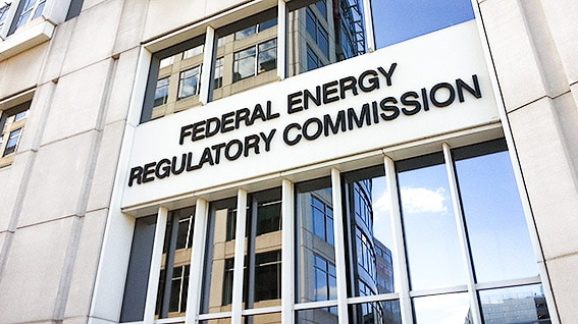
Via www.FERC.gov
Thank you for the opportunity to comment on the Federal Energy Regulatory Commission’s (FERC) Notice of Inquiry regarding the certification of new natural gas facilities.[1] This comment letter addresses questions C3, C4, C6, and C7, which concern whether, and if so how, FERC should take into account greenhouse gas (GHG) emissions and potential climate change damages in National Environmental Policy Act (NEPA) reviews of proposed interstate natural gas pipelines.[2]
Those questions may be summarized as follows:
- Should FERC calculate the potential GHG emissions from upstream activities such as the drilling of natural gas wells (C3)?
- Should FERC calculate the potential GHG emissions from downstream consumption of gas (C4)?
- Should FERC weigh potential climate change damages against favorable economic benefits in determining whether a proposed project is required by public convenience and necessity (C6)?
- Should FERC use social cost of carbon analysis to inform determinations of public convenience and necessity (C7)?
In effect, the Notice asks whether FERC should comply with the rescinded[3] Obama administration Council on Environmental Quality (CEQ) “Guidance” requiring agencies to estimate both the direct and indirect (upstream and downstream) emissions of individual projects, and to quantify the associated climate change damages using U.S. Government estimates of the social cost of carbon (SCC).[4] The Notice also asks whether FERC should base public convenience and necessity determinations, at least in part, on SCC-estimated climate change impacts.
The answer to all those questions is no. Saving the planet one gas pipeline at a time is a fool’s errand. Worse, importing climate concerns and SCC analysis into public convenience and necessity determinations will fuel spurious ideological controversies, discourage economically-beneficial investment in U.S. energy infrastructure, and make natural gas prices more volatile.
I proceed now to consider Questions C3, C4, C6, and C7.
I. Should FERC calculate the potential GHG emissions from upstream activities such as the drilling of natural gas wells and downstream emissions from electric generation and other end-uses (C3, C4)?
No. This would serve no purpose except to further politicize decisions that should be based on factors materially affecting the public convenience and necessity.
Fool’s Errand
Individual pipeline projects contribute less than a drop in the bucket to the global GHG emissions pool. That holds not just for a project’s direct emissions but also for indirect (upstream and downstream) emissions. It is not even theoretically possible to connect a particular pipeline to any specific climate change effect.
Consider, for example, the Keystone XL Pipeline. The KXL has the capacity to transport 3.4 to 120 times more energy (measured in Btus) than several recently approved gas pipelines, and each Btu of crude oil emits approximately one-third more carbon dioxide (CO2) than each Btu of natural gas. The Box Insert below provides details and documentation.
|
One barrel of crude oil contains about 6 million Btu.[5] One cubic foot of natural gas contains 1,037 Btu.[6] Recently approved natural gas pipeline projects in the Northeast vary in size from 0.02 Bcf/d to 1.4 Bcf/d.[7] The KXL will have the capacity to deliver 830,000 barrels of Canadian crude per day.[8] Hence, the KXL will deliver up to 4.98 trillion Btu per day—about 3.4 times more energy than a 1.4Bcf/d gas pipeline and 120 times more than a 0.02 Bcf/d pipeline. In addition, each Btu of petroleum-based fuels emits about 34-38 percent more CO2 than each Btu of natural gas.[9] |
Yet, even under the unrealistic assumption that the KXL runs at full capacity (830,000 barrels per day) year-round and each barrel is additional oil produced solely to meet demand induced by the pipeline, the project would add less than 0.01°C of warming to global temperatures between now and 2100, according to MAGICC, EPA’s climate change simulator.[10]
That vanishingly small and likely unverifiable change[11] in average global temperatures 82 years from now would have no discernible impact on weather patterns, crop yields, polar bear populations, or any other environmental condition people actually care about. Climatologically, the Keystone XL Pipeline is irrelevant. The climate-change impacts of any natural gas pipeline will be even more miniscule.
Promoting Irrationality
The rescinded CEQ Guidance claims that incorporating GHG emissions and climate change effects in NEPA review will lead to “better decisions.”[12] The Keystone XL Pipeline controversy shows that incorporating climate concerns leads to irrational decisions.
The State Department’s NEPA review concluded that the KXL is actually the ‘climate friendly’ option. What chiefly determines international oil flows is global demand, not particular infrastructure projects. Accordingly, State concluded that U.S. refiners would import about the same quantity of Canadian crude whether permission to build the KXL is granted or denied. However, the alternative modes of transport—crude-by-rail, smaller pipelines, and barges—are less energy efficient than a large pipeline. Consequently, blocking the KXL would increase net carbon dioxide (CO2) emissions by 28 to 42 percent.[13] That finding plus the trivial amount of warming attributable to the KXL even under unrealistic assumptions should have ended the controversy.
However, the mere fact that State’s NEPA analysis considered greenhouse gas emissions and climate change effects enabled climate campaigners to organize years of protest, mobilize thousands of activists, and demonize a single infrastructure project as a planet wrecker.[14]
Although Canada is our closest ally, biggest trading partner, and largest supplier of imported oil, and even though pipelines are more efficient, less liable to oil spill risk, and safer than alternative routes of delivery,[15] Obama reduced the “national interest determination” to a single factor: Whether the KXL would “significantly exacerbate the problem of carbon pollution.”[16] This monomaniacal focus turned the pipeline into a pretext for keeping the Democratic Party’s environmentalist base angry and mobilized.
Shortly before the Paris climate summit, Obama concluded that the KXL is not in the U.S. national interest. He explained: “America is now a global leader when it comes to taking serious action to fight climate change, and frankly, approving this project would have undercut that leadership.”[17] In other words, political optics would now determine whether investment in energy infrastructure is in the national interest.
For the Obama administration, the point of keeping the Keystone XL pot boiling, year after year, was not to gather more data for State’s multiple environmental assessments but to recruit activists and spread fear and loathing of “dirty” fuels.
The anti-fracking movement seeks to ban shale gas production[18] on the basis of unscientific alarmism.[19] FERC should be wary of encouraging fracking foes to “Keystone” public convenience and necessity determinations. Reviving the Obama NEPA policy will not mitigate climate change risks but will feed the hubris of those who believe government exists to bankrupt industries they don’t like.
II. Should FERC weigh potential climate change damages against favorable economic benefits in determining whether a proposed project is required by public convenience and necessity (C6)?
No. As explained above, the climate change damages of any particular pipeline will occur many decades into the unknowable future, if at all, and even then, will likely be too small to detect or verify. In contrast, the economic benefits of natural gas pipelines are substantial and verifiable. A May 2016 report by IHS Economics for the National Association of Manufacturers illustrates the point.
Gas Pipelines: Economic Benefits
Noting that the rapid growth of shale gas production in some major shale plays has created bottlenecks in areas with insufficient transmission pipeline capacity, IHS estimates “that approximately $25.8 billion was spent in the U.S. in 2015 to construct 6,028 miles of new natural gas transmission pipelines, resulting in a temporary increase in employment of 347,788 jobs, with 59,874 in the manufacturing sector.” In addition, “the construction spending is expected to have contributed $34 billion to GDP and $21.9 billion to labor income in 2015.”
In general, reducing transmission constraints lowers natural gas prices, which in turn lowers production costs for “energy-intensive industries such as chemicals, metals, food, and refining.” That makes U.S. manufacturers more competitive and communities with low-priced gas more attractive for industrial development. The IHS report elaborates:
The improved competitive positioning of industries in the manufacturing sector is shaping state and local economic development strategies across the country. Increased supplies of NG [natural gas], especially at lower delivered prices, enhances the competitiveness of economies by making them more attractive to manufacturing activities that are large, and intensive users of NG such as chemicals, food, paper, and metals. . . . In addition to providing key inputs for the construction of NG pipelines, the manufacturing sector will also benefit economically from the capital expenditures for new electric generating plants and for facilities used to process and store NG and natural gas liquids (NGLs).[20]
In EIA’s Annual Energy Outlook 2018, U.S. natural gas production increases through 2050 in all scenarios, while consumption increases in all scenarios except the Low Oil and Gas Resource and Technology Case:[21]
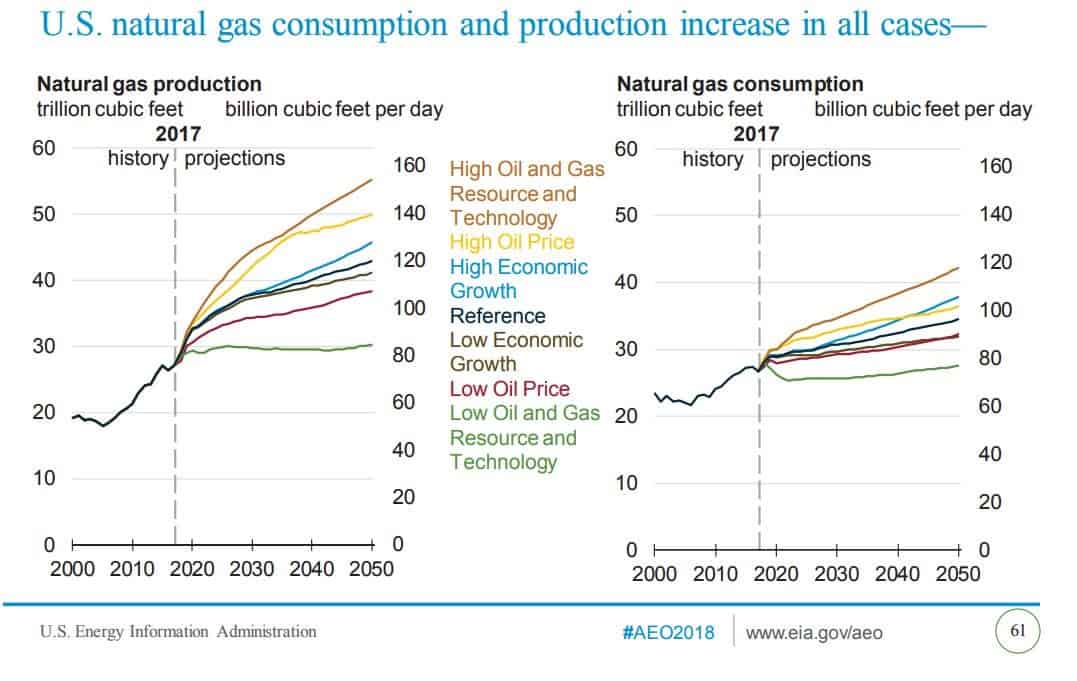
Shale and tight oil plays are expected to provide the lion’s share of new production through 2050:[22]
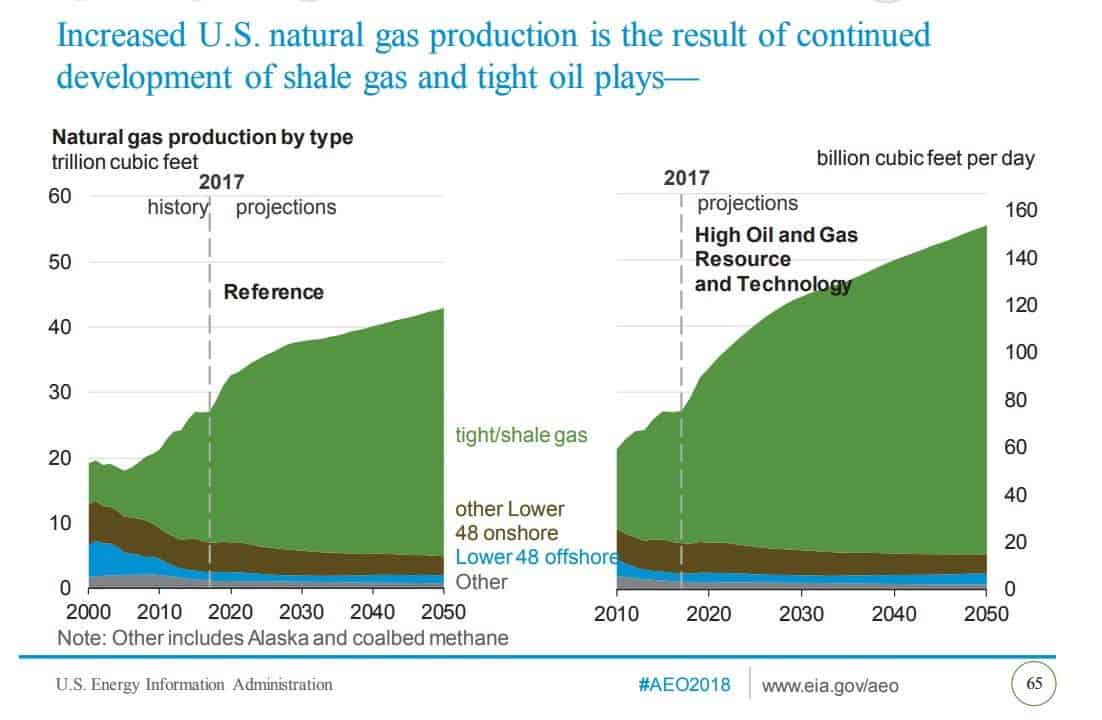
Because most gas pipelines were built before the Shale Gale, there is a “mismatch, geographically, in the growth in NG demand and supply in the U.S. Lower 48,” according to the IHS report:
The sum of exports, power, and industrial demand will substantially exceed supply growth in the West South Central, East South Central, and Mountain regions, creating a demand for new NG infrastructure to serve these divisions. In contrast, supply growth will significantly outpace demand growth in the Mid-Atlantic region. In addition to the Marcellus and Utica gas production developments, there will be some other areas of significant pipeline and processing plant infrastructure activity. For instance, LNG exports will, in many cases, require upstream pipeline capacity expansions—of varying degrees—to support steady-state utilization of liquefaction facilities.[23]
More recently, IHS is forecasting that the Permian Basin could double oil production by 2023, reaching 5.4 million bpd—more than any foreign country except for Russia and Saudi Arabia. Natural gas extracted as a byproduct of Permian oil production is also expected to double by 2023. The total cost for development and production is estimated at $308 billion, but that is not the “primary challenge” facing industry. As Jeff Mosier of the Dallas Morning News puts it, “The most likely roadblock is logistics; the Permian Basin’s massive growth is pushing pipeline capacity—both oil and natural gas—to its limits.”[24]
Now is not a good time for FERC to burden gas infrastructure with novel political risks that can only discourage investment without yielding any detectable climate benefits.
Counterproductive Too
Ironically, adding climate litmus tests to public convenience and necessity determinations could both increase GHG emissions and hinder social progress in reducing climate-related risks.
Since the mid-2000s, annual U.S. CO2 emissions decreased by about 760 million metric tons, making the United States the world emission-reduction leader.[25] The fracking boom made those cuts possible, as cheap gas replaced coal as an electricity fuel and provided backup for intermittent renewables. Gumming up gas infrastructure permitting with pointless climate controversy might have chilled investment in fracking operations, resulting in lower supplies and higher prices.
Granted, higher prices in the future could reduce gas consumption and the associated emissions. However, higher gas prices would also increase the incentive for utilities to use more coal-fired generation.[26] Consequently, if the policy objective is to cut GHG emissions, applying climate litmus tests to gas pipelines could backfire.
More importantly, blocking investment in energy infrastructure could make people more vulnerable to the vagaries of weather and climate. During the “Bomb Cyclone” of January 2018, pipeline constraints in the Northeast drove natural gas spot prices above $100/MMBtu, according to David Braziel of RBN Energy. Demand for gas fell by 4 bcf/d, as power producers switched to usually pricier coal and oil:
With limited pipeline capacity keeping more gas from reaching Transco Zone 5 and 6 no matter the price, spot prices continued to climb during the January bomb cyclone, allowing alternatives to enter the market, Braziel said. First came coal at around $3-6/MMBtu, then $7-10 brought “some of the highest cost gas supplies” into the market. When still more gas was demanded, prices rose to $20, making oil-fired generation economic.
“On a few days this winter, even that wasn’t enough,” Braziel said. “Gas prices continued to rise,” likely to levels where some industrial customers were priced out of the market.[27]
Taking a broader view of the subject, fossil energy consumption is strongly correlated with long-term improvements in all major indicators of human health and well-being, including per capita income, per capita food availability, and life years lost due to disease and disability.[28]
As energy analyst Alex Epstein observes, human beings empowered with cheap, reliable, and scalable fossil energy did not take a safe climate and make it dangerous; rather, they took a naturally dangerous climate and made it much safer.[29] The evidence of decreasing climate-related risk is overwhelming.
Consider drought, historically the leading source of climate-related deaths because it limits access to food and water. Fossil fuels reduce drought risk in manifold ways.
First and foremost, mankind’s use of fossil energy dramatically increases the productivity of food production, transport, and storage. As climate economist Indur Goklany observes, every critical input of modern agriculture depends to some extent on fossil fuels:
Fossil fuels provide both the raw materials and the energy for the manufacture of fertilizers and pesticides; farm machinery is generally run on diesel or another fossil fuel; and irrigation, where it is employed, often requires large amounts of energy to operate pumps to move water.[30]
Fossil fuels also provide energy for refrigeration and raw material for plastic packaging—technologies critical to limiting food spoilage and waste. Fossil fuels are essential for exporting agricultural technology and improved cultivars from factories and research centers to farms, and for transporting food from farms to population centers and from surplus to deficit regions. In addition, fossil-fueled economies create the economic surpluses, physical assets, and expertise required for effective emergency relief programs. Finally, CO2 emissions boost crop yields, in part by helping water-stressed plants retain moisture.[31]
As the chart below shows, drought killed approximately 472,000 people in the 1920s. What happened since then? Fossil-fuel consumption soared, global CO2 concentrations increased by almost one-third,[32] and the Earth warmed about 0.8°C.[33] Yet annual global drought-related deaths declined by 99.8 percent (from 130,000 to 200) between the 1920s and recent decades. Drought-related death rates (per million population) declined by 99.9 percent.[34]
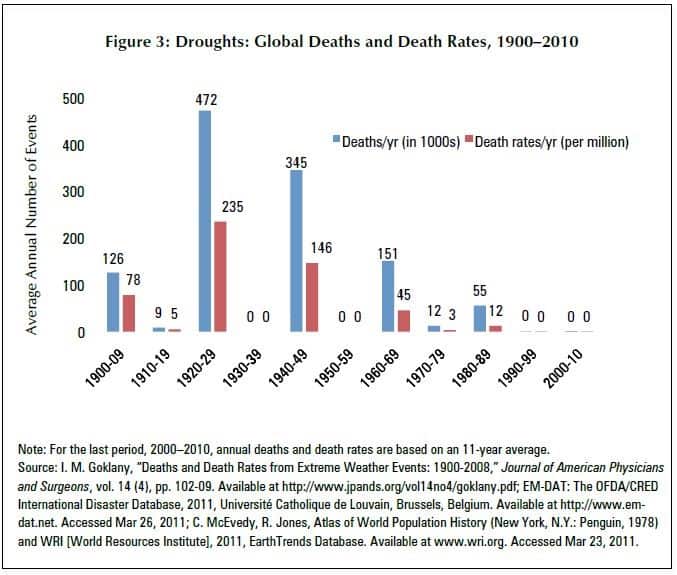
Carbon dioxide-emitting technologies have made similar contributions to substantial declines in deaths and death rates related to floods, storms, heat waves, extreme cold, and other forms of extreme weather.[35]

Carbon-based fuels have made humanity wealthier, better fed, and safer—and the climate much less lethal—than would otherwise be the case. If CO2 emissions have an adverse impact on droughts, storms, or floods (detection remains elusive),[36] the societal impacts are so tiny compared to the immense long-term improvements that it is impossible to discern a climate signal in the major indices of health and welfare.
What we can say is that the long term trend is in the right direction. Since 1990, weather-related damages as a share of global GDP declined by about 25 percent.[37]
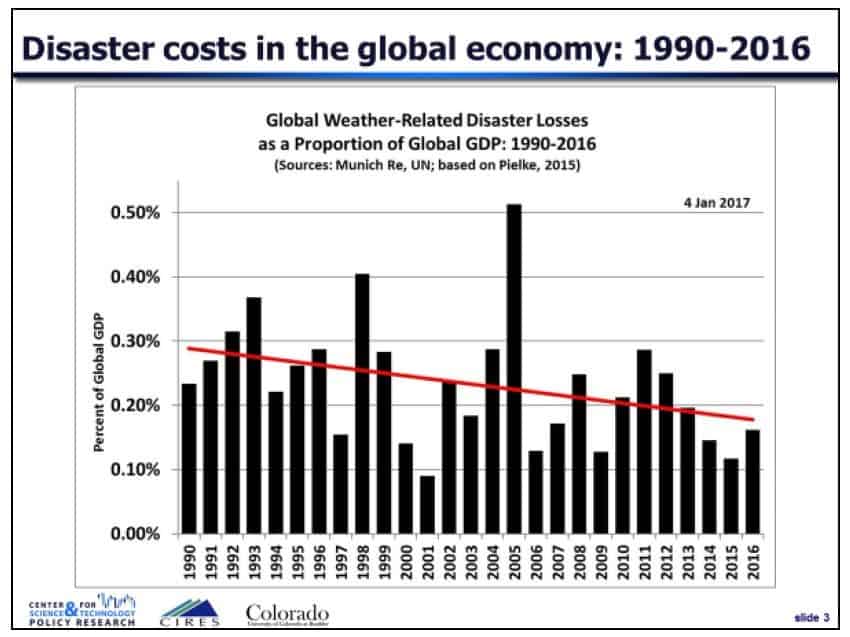
Only those who ignore the big picture of improving health and safety could possibly imagine that blocking particular fossil-fuel infrastructure projects will advance human welfare or make the climate more livable. FERC should decline to patronize such muddled thinking.
III. Should FERC use social cost of carbon analysis to inform determinations of public convenience and necessity (C7)?
No. The social cost of carbon is too speculative and subjective to inform public policy decisions. Incorporating SCC analysis will turn public convenience and necessity determinations into pseudo-science. Because pipelines are built to last, opponents can multiply the presumed SCC by the estimated direct and indirect emissions over decades, and fool people into believing the project’s social costs, although utterly unverifiable, outweigh its manifest economic benefits.
SCC Basics
Before elaborating those points, let’s first review how SCC estimation works. The following discussion borrows freely from the Obama EPA’s 2016 Social Cost of Carbon Fact Sheet.[38]
The social cost of carbon is an estimate, in dollars, of the cumulative long-term damage done by a ton of CO2 emitted in a given year. That dollar figure also represents an estimate of the benefit of avoiding or reducing one ton of CO2 emissions.
The computer programs used to project SCC values are called integrated assessment models (IAMs) because they combine a climate model, which estimates the physical impacts of CO2 emissions, with an economic model, which estimates the dollar value of climate change impacts on agricultural productivity, property damages, and other economic variables.
In federal agency analyses, the cumulative damage of an incremental ton of CO2 emissions is estimated from the year of the emission’s release until 2300. SCC estimates are highly sensitive to the discount rates chosen to calculate the present value of future emissions and reductions. The lower the discount rate, the higher the present value of future climate damages and emission reductions, and vice versa.
Federal agencies average the results of three IAMs to estimate SCC values. For any given year, there are four SCC estimates. The first three values present the SCC at discount rates of 5, 3, and 2.5 percent. Agencies also use a fourth value to represent the incremental damages associated with “lower-probability, higher-impact” events such as ice sheet collapse.[39]
Pretense of Knowledge and Precision
IAMs have a role in academic research, allowing analysts to see how different physical and economic assumptions drive estimates of climate-related impacts and regulatory benefits. However, using IAMs to make policy “suggests a level of knowledge and precision that is simply illusory, and can be highly misleading,” MIT professor Robert Pindyck cautions.[40] He explains:
The modeler has a great deal of freedom in choosing functional forms, parameter values, and other inputs, and different choices can give wildly different estimates of the SCC [social cost of carbon] and the optimal amount of abatement. You might think that some input choices are more reasonable or defensible than others, but no, “reasonable” is very much in the eye of the modeler. Thus these models can be used to obtain almost any result one desires.[41]
What climate campaigners and their agency allies typically desire is to sustain the narrative that climate change is “worse than we thought.” Unsurprisingly, the central SCC estimates in the Obama administration’s 2013 technical support document (TSD) are almost 60 percent higher than the corresponding estimates in the administration’s 2010 TSD.[42] In four short years, cumulative climate change impacts from 2000 to 2300 became almost 60 percent worse!

Raise the SCC estimate high enough, and modelers can make fossil fuels look unaffordable no matter how cheap and renewable energy look like a bargain at any price. Consider a study co-authored by Chris Hope, creator of the PAGE (Policy Analysis of the Greenhouse Effect) model, one of the three IAMs generating the Obama administration’s SCC estimates.
Using a 1 percent discount rate, Hope and his colleagues estimate that in 2010, the SCC was already $266/ton—830 percent larger than the Obama administration’s central SCC estimate. They conclude that new renewable generation is more “efficient” than either new gas or existing coal generation.[43]
The ease with which such computer-aided sophistry could be weaponized in FERC infrastructure proceedings is obvious. To puff up their raw political preferences, opponents of gas pipelines could invoke SCC analysis allegedly demonstrating that investment in new gas generation is inefficient.
SCC modelers are free to select below-market discount rates because discounting involves ethical judgments about intergenerational equity. How much material well-being should the poorer present generation be willing to sacrifice to enhance the welfare of wealthier future generations? That is primarily a philosophic rather than a technical or scientific question, which in practice means it is often an ideological or partisan question.
Modelers also have great freedom in selecting other critical IAM inputs because the physical and economic variables affecting carbon’s social cost are so uncertain. SCC estimates are intractably conjectural because:
- No one can forecast the baseline emission trajectory of the global economy out to 2300, but it is only in relation to some assumed baseline that the incremental effects of the next ton of CO2 might be estimated. SCC modelers are free to use any business-as-usual scenario published in the literature, including the ever-popular but increasingly obsolete RCP 8.5, which assumes coal generation surges ahead of gas generation through 2100 (see image below).[44]
- Scientists do not know the relative strength of the positive and negative feedbacks that amplify or constrain the climate’s response to rising CO2 concentrations. That is why the Intergovernmental Panel on Climate Change (IPCC) has been unable to narrow the “likely” range of “equilibrium climate sensitivity” (ECS)—the long-term warming from a doubling of atmospheric CO2 concentration. The likely range is 1.5°C to 4.5°C in both the IPCC’s first (1990) report[45] and fifth (2013) report.[46]
- To guestimate climate damages, IAMs must also make non-validated assumptions about how rising temperatures will affect weather patterns, ice-sheet dynamics, and other natural phenomena, and how such physical changes will affect agriculture, other climate-sensitive industries, and consumption absent adaptive responses.
- Human beings use technology to adapt to environmental conditions. Consequently, the “damage functions” in IAMs—the projected impacts of climate change on consumption, climate-sensitive industries, and human health—depend on assumptions about how technology will develop as the world warms. Nothing is harder to forecast than long-term technological change.
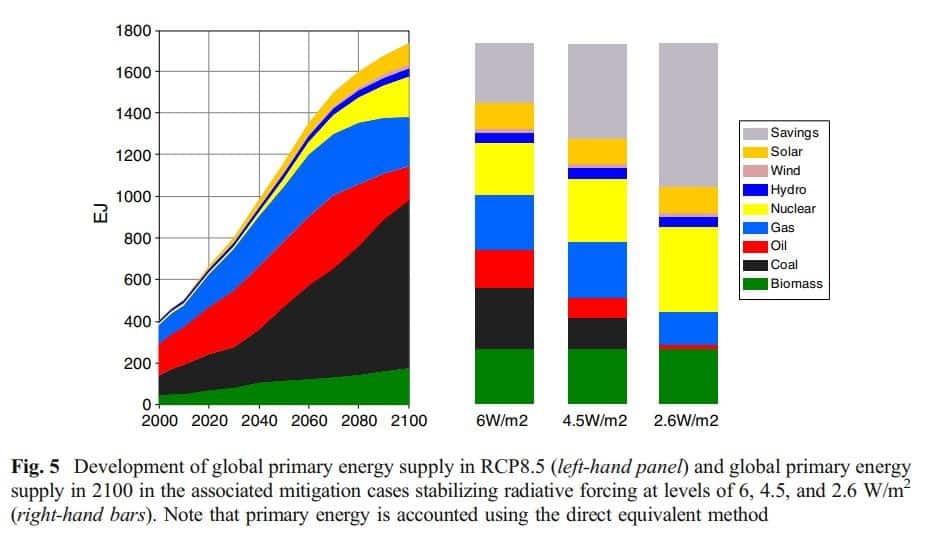
IV. Conclusion
Mitigating climate change one project at a time is a fool’s errand bound to impose real costs out of all proportion to the speculative benefits. Because affordable energy and economic growth are critical to human mastery of climate-related risks, and because the climatological significance of any infrastructure project is for all practical purposes nil, blocking interstate pipelines in the name of climate protection will do more harm than good to public health and welfare.
In short, NEPA review is an inappropriate basis for determining climate change policy, and project-related GHG emissions should not be a factor determining whether FERC certifies the public convenience and necessity of proposed interstate gas pipelines.
The rejoinder, conveniently furnished by the Obama CEQ Guidance, is that although “individual sources of emissions each make relatively small additions to global atmospheric GHG concentrations,” the myriad diverse sources “collectively have huge impact.”[47] The policy implication is not hard to fathom. If thousands of individual projects collectively have a “huge impact,” then permission must be denied to as many as possible—ideally to all.
The chief problem with that policy—aside from the enormous economic losses and suffering it would entail—is that Congress has not authorized it.
Under the Paris Agreement, the Obama administration sought to commit the United States to an emission-reduction target “consistent with a path to deep de-carbonization.” As the U.S. nationally determined contribution (NDC) explained, the administration’s pledge to cut emissions 26-28 percent below 2005 levels by 2025 “is consistent with a straight line emission reduction pathway from 2020 to deep, economy-wide emission reductions of 80 percent or more by 2050.”[48]
Pursuing “deep de-carbonization” in earnest might well require agencies across the federal government to reject increasing numbers of applications to extract, transport, and combust fossil fuels. However, neither NEPA nor the Natural Gas Act authorizes FERC to mandate a national energy transformation away from fossil fuels.
FERC should therefore decline to do piecemeal what it clearly lacks authority to do on the scale and schedule desired by climate campaigners and fracking foes.
Respectfully Submitted,
Marlo Lewis, Jr., Ph.D., Senior Fellow
Competitive Enterprise Institute
[email protected]; 202-331-2267
[1] Federal Energy Regulatory Commission, Certification of New Natural Gas Facilities, 83 FR 18020-18032, April 25, 2018, file:///E:/FERC/Natural%20Gas%20Act/FERC%20Certification%20of%20New%20Interstate%20Natural%20Gas%20Facilities%20NOI%20April%2025,%202018%20PL18-1-000.pdf
[2] 83 FR 18032
[3] 83 FR 18028, citing Presidential Executive Order on Promoting Energy Independence and Economic Growth, March 28, 2017, https://www.whitehouse.gov/presidential-actions/presidential-executive-order-promoting-energy-independence-economic-growth/
[4] Council on Environmental Quality, Revised Draft Guidance on the Consideration of Greenhouse Gas Emissions and the Effects of Climate Change in NEPA Reviews, December 2014, https://ceq.doe.gov/docs/ceq-regulations-and-guidance/nepa_final_ghg_guidance.pdf (hereafter CEQ Guidance)
[5] Energy Information Administration (EIA), Conversion Factors – Heat Contents, https://www.eia.gov/outlooks/aeo/pdf/appg.pdf
[6] EIA, Energy Units and Calculators Explained, https://www.eia.gov/energyexplained/index.php?page=about_energy_units
[7] EIA, “Cumulative additional natural gas pipeline capacity originating in the Northeast,” Natural Gas Weekly, November 16, 2017, https://www.eia.gov/naturalgas/weekly/archivenew_ngwu/2017/11_16/
[8] Paul W. Parfomak, et al., Keystone XL Pipeline Project: Key Issues, Congressional Research Service, December 2, 2013, https://fas.org/sgp/crs/misc/R41668.pdf
[9] EIA, “How much carbon dioxide is produced when different fuels are burned?” https://www.eia.gov/tools/faqs/faq.php?id=73&t=11
[10] Testimony of Paul C. “Chip” Knappenberger before the Subcommittees on Energy and Environment of the House Committee on Science, Space, and Technology, hearing on “Keystone XL Pipeline: Examination of the Scientific and Environmental Issues,” May 7, 2013, http://www.cato.org/publications/testimony/keystone-xl-pipeline-examination-scientific-environmental-issues
[11] According to NOAA, 0.08°C is the margin of error in estimates of average annual global temperature, or eight times the increase from the KXL under the aforementioned unrealistic assumptions. See NOAA, “Global Temperature Uncertainty,” https://www.ncdc.noaa.gov/monitoring-references/faq/global-precision.php
[12] CEQ Guidance p. 6
[13] State Department, Final Supplemental Environmental Impact Assessment for the Keystone XL Pipeline Project, Executive Summary, January 2014, Errata Sheet, 34, http://keystonepipeline-xl.state.gov/documents/organization/221135.pdf
[14] Marlo Lewis, “Keystone XL: Does Hatred Blind Peace Prize Winners?” GlobalWarming.Org, April 18, 2018, http://www.globalwarming.org/2014/04/18/keystone-xl-does-hatred-blind-peace-prize-winners/
[15] State, FSEIS, ES
[16] Remarks by the President on Climate Change, Georgetown University, June 25, 2013, http://www.whitehouse.gov/the-press-office/2013/06/25/remarks-president-climate-change
[17] Elise Labott and Dan Berman, CNN, “Obama rejects Keystone XL Pipeline,” CNN Politics, November 6, 2015, https://www.cnn.com/2015/11/06/politics/keystone-xl-pipeline-decision-rejection-kerry/index.html
[18] Jon Hurdle, “With governor’s signature, Maryland becomes third state to ban fracking,” State Impact Pennsylvania, April 4, 2017, https://stateimpact.npr.org/pennsylvania/2017/04/04/with-governors-signature-maryland-becomes-third-state-to-ban-fracking/
[19] Energy In Depth, “Gasland Debunked,” https://www.energyindepth.org/gasland-debunked/
[20] Brendan O’Neil, Phil Hopkins, and Julie Gressley, IHS Economics, The Economic Benefits of Natural Gas Pipeline Construction for the Manufacturing Sector, National Association of Manufacturers, 2016, p. 4, http://www.nam.org/Data-and-Reports/Reports/Natural-Gas-Study/Energizing-Manufacturing-Full-Report/ (hereafter IHS Economics)
[21] EIA, Annual Energy Outlook 2018 with Projections to 2050, February 6, 2018, p. 61, https://www.eia.gov/outlooks/aeo/pdf/AEO2018.pdf
[22] EIA, AEO2018, p. 65
[23] IHS Economics, p. 22
[24] Jeff Mosier, “Permian Basin could double oil production by 2023, trailing only Saudi Arabia, Russia,” Dallas Morning News, June 14, 2018, http://www.postbulletin.com/news/business/permian-basin-could-double-oil-production-by-trailing-only-saudi/article_5b9e95ef-5b6c-549c-9a56-c94562c6cfb0.html
[25] Environmental and Energy Study Institute, “U.S. Leads in Greenhouse Gas Reductions, But Some States Fall Behind,” March 27, 2018, http://www.eesi.org/articles/view/u.s.-leads-in-greenhouse-gas-reductions-but-some-states-are-falling-behind
[26] Energy Information Administration, “Coal may surpass natural gas as the most common electricity fuel this winter,” November 18, 2016, https://www.eia.gov/todayinenergy/detail.php?id=28832
[27] Jeremiah Shelor, “Natural Gas Pipeline Constraints Destroyed Up to 4 Bcf/d in January Bomb Cyclone, Says RBN,” NGI Daily’s Gas Price Index, June 11, 2018, http://www.naturalgasintel.com/articles/114675-natural-gas-pipeline-constraints-destroyed-up-to-4-bcfd-in-january-bomb-cyclone-says-rbn
[28] Marlo Lewis, “Fossil Fuels: Curse or Blessing?” Inside Sources, April 20, 2018, https://cei.org/content/fossil-fuels-curse-or-blessing
[29] Alex Epstein, The Moral Case for Fossil Fuels (New York: Portfolio/Penguin, 2014), pp. 119-140.
[30] Indur M. Goklany, Humanity Unbound: How Fossil Fuels Saved Humanity from Nature and Nature from Humanity, Cato Institute Policy Analysis No. 715, p. 9, December 20, 2012, http://www.cato.org/sites/cato.org/files/pubs/pdf/pa715.pdf
[31] Center for the Study of Carbon Dioxide and Global Change, C4 Plants (Water Use Efficiency), http://www.co2science.org/subject/c/c4plantwue.php
[32] NASA, Global CO2 Mean Mixing Ratios (ppm): Observations, http://data.giss.nasa.gov/modelforce/ghgases/Fig1A.ext.txt
[33] NASA, GISS Surface Temperature Analysis, http://data.giss.nasa.gov/gistemp/graphs_v3/
[34] Indur M. Goklany, Wealth and Safety: The Amazing Decline in Deaths from Extreme Weather in an Era of Global Warming, 1900-2010, Reason Foundation, Policy Study 393, September 2011, p. 15, https://reason.org/files/deaths_from_extreme_weather_1900_2010.pdf
[35] Ibid., pp. 8-9
[36] “Current datasets indicate no significant observed trends in global tropical cyclone frequency over the past century.” “In summary, there continues to be a lack of evidence and thus low confidence regarding the sign of trend in the magnitude and/or frequency of floods on a global scale.” “[T]here is low confidence in detection and attribution of changes in drought over global land areas since the mid-20th century.” IPCC, Climate Science 2013: The Physical Science Basis, “Detection and Attribution of Climate Change: from Global to Regional,” Chapter 10, p. 913, http://www.ipcc.ch/pdf/assessment-report/ar5/wg1/WG1AR5_Chapter10_FINAL.pdf
[37] Statement of Dr. Roger Pielke, Jr. to the House Committee on Science, Space, and Technology, hearing on Climate Science: Assumptions, Policy Implications, and the Scientific Method,
March 29, 2017, https://science.house.gov/sites/republicans.science.house.gov/files/documents/HHRG-115-SY-WState-RPielke-20170329.pdf
[38] EPA Fact Sheet: Social Cost of Carbon, 2016, https://www.epa.gov/sites/production/files/2016-12/documents/social_cost_of_carbon_fact_sheet.pdf
[39] The Trump administration proposes to revise regulatory accounting gimmicks that inflate SCC values. Although helpful, the proposed reforms do no challenge agencies’ reliance on dated (and likely overheated) climate sensitivity assumptions and their use of two structurally-biased IAMs that do not include robust carbon dioxide fertilization benefits. For further discussion, see Marlo Lewis, Free Market Groups’ Comments on EPA’s Proposal to Repeal the Clean Power Plan, April 26, 2018, https://cei.org/sites/default/files/CEI_Comments_-_Proposed_Rule_-_Clean_Power_Plan_Repeal.pdf
[40] Robert Pindyck, Climate Change Policy: What Do Models Tell Us? Working Paper 19244, July 2013, http://www.nber.org/papers/w19244
[41] Ibid., p. 5
[42] U.S. Government Accountability Office, Regulatory Impact Analysis: Development of Social Cost of Carbon Estimates, July 2014, p. 7, https://www.gao.gov/assets/670/665016.pdf
[43] Laurie Johnson, Starla Yeh, and Chris Hope, “The Social Cost of Carbon: Implications for Modernizing Our Electricity,” Journal of Environmental Studies and Sciences, December 2013, Volume 3, Issue 4, pp. 369–375, https://link.springer.com/article/10.1007/s13412-013-0149-5
[44] Marlo Lewis, EPA’s Flimflam Climate Action Report, Part 2, GlobalWarming.Org, July 23, 2015, http://www.globalwarming.org/2015/07/23/epas-climate-action-flimflam-report-part-2/. Image source: Riahi et al. RCP 8.5—A scenario of comparative high greenhouse gas emissions, Climate Change (2011) 109: 33-57, http://www.globalwarming.org/wp-content/uploads/2015/07/Riahi-RCP8.5-A-scenario-of-comparatively-high-greenhouse-gas-emissions.pdf
[45] IPCC, First Assessment Report (FAR), Climate Change: The IPCC Scientific Assessment (1990), Chapter 5, Equilibrium Climate Change, p. 139, https://www.ipcc.ch/ipccreports/far/wg_I/ipcc_far_wg_I_chapter_05.pdf
[46] IPCC, Climate Change 2013: The Physical Science Basis. Contribution of Working Group I to the Fifth Assessment Report of the Intergovernmental Panel on Climate Change, Summary for Policymakers, p. 16, http://www.ipcc.ch/pdf/assessment-report/ar5/wg1/WG1AR5_SPM_FINAL.pdf
[47] CEQ Guidance, p. 9
[48] U.S. Intended Nationally Determined Contribution, p. 1, http://www4.unfccc.int/ndcregistry/PublishedDocuments/United%20States%20of%20America%20First/U.S.A.%20First%20NDC%20Submission.pdf